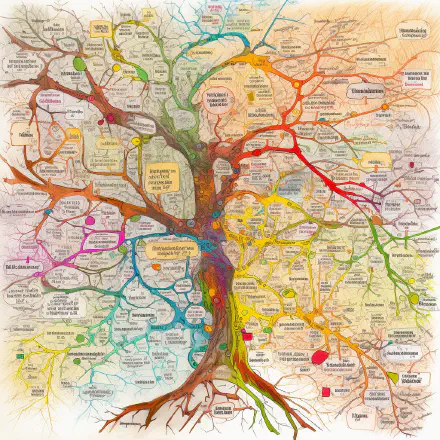
Analyze
Analyzing information is a crucial part of applied thinking. It involves breaking down data, ideas, or concepts into smaller parts to gain a deeper understanding of them. Analyzing information can help you identify patterns, relationships, and potential opportunities or issues that may not have been apparent at first glance.
Methods for Analysis
There are many methods you can use to analyze information, such as:
- SWOT analysis: A framework used to identify Strengths, Weaknesses, Opportunities, and Threats related to a specific business or project. It’s a tool commonly used in strategic planning.
- Root cause analysis: A problem-solving technique that involves identifying the underlying cause of an issue or problem. By understanding the root cause, you can develop effective solutions to prevent the issue from recurring.
- Data analysis: A process of inspecting, cleaning, transforming, and modeling data to discover useful information, draw conclusions, and support decision-making.
Benefits of Analysis
Analyzing information can provide many benefits, such as:
- Clarity: Analyzing information can help you gain a clearer understanding of complex topics or issues.
- Improved decision-making: By breaking down information into smaller parts, you can identify potential opportunities or issues that may impact your decision-making process.
- Increased efficiency: Analyzing information can help you identify potential inefficiencies in a process or system, allowing you to make improvements and increase efficiency.
In summary, analyzing information is an important aspect of applied thinking. By utilizing various methods for analysis, you can gain a deeper understanding of complex topics, improve decision-making, and increase efficiency.
Innovate
Innovation is a valuable skill in today’s fast-paced world and has become an essential aspect of applied thinking. To innovate, you need to cultivate an environment that fosters creativity, risk-taking, and exploration. It involves challenging the status quo and thinking outside the box to devise new and creative ways to approach problems.
Some subtopics to consider when discussing innovation include:
Characteristics of Innovative Thinkers
Innovative thinkers share specific traits that enable them to identify opportunities and develop creative solutions to problems. These traits include curiosity, open-mindedness, persistence, and the willingness to take calculated risks.
Methods for Encouraging Innovation
Encouraging innovation in your personal or professional life requires creating an environment that fosters creativity and exploration. Some methods to encourage innovation include setting aside time for brainstorming, collaborating with others to generate new ideas, and experimenting with different approaches.
Examples of Innovation in Practice
Innovation is present in almost every aspect of modern society, from technology and medicine to business and entertainment. Some prominent examples of innovation include the development of smartphones, social media platforms, and renewable energy sources.
In conclusion, innovation is a critical aspect of applied thinking and requires a willingness to take risks, challenge the status quo, and explore creative solutions to problems. By embracing innovation, you can become a more effective problem solver and bring new and exciting ideas to the table.
Strategize
Strategizing involves developing a plan of action to achieve a specific goal. It is an essential skill for applied thinking and requires careful consideration of different factors. Here are some key subtopics to keep in mind when strategizing:
Define the Goal
The first step in strategizing is to define the objective clearly. It is crucial to have a specific, measurable, and attainable goal in mind. Without a clear goal, it is challenging to develop a plan of action.
Consider Different Perspectives
When strategizing, it is essential to consider different perspectives. Different people in the organization may have varying ideas about the best approach to achieve the goal. By considering different perspectives, you can come up with a well-rounded plan that takes into account everyone’s ideas.
Evaluate Resources
It is crucial to evaluate the resources available when developing a strategic plan. You need to consider the budget, man-power, technology, and other resources needed to achieve the goal. By doing so, you can determine if the plan is realistic and achievable.
Identify Potential Obstacles
When strategizing, it is important to anticipate potential obstacles. You need to consider what could go wrong and how to mitigate risks. By identifying potential obstacles, you can prepare for them and develop a contingency plan to overcome them.
Develop a Timeline
Strategizing requires developing a timeline to achieve the goal. You need to consider how much time each step of the plan will take, and when the project will be completed. By developing a timeline, you can keep track of progress and ensure everyone is on schedule.
Monitor Progress
Finally, when strategizing, it is crucial to monitor progress regularly. You need to evaluate whether the plan is working and if it needs any adjustments. By monitoring progress, you can identify areas that need improvement and make changes as necessary.
In conclusion, strategizing is an essential skill for applied thinking. By considering different perspectives, evaluating resources, identifying potential obstacles, developing a timeline, and monitoring progress, you can develop a comprehensive plan of action to achieve your goals.
Plan
Planning is an essential component of applied thinking. By creating a clear plan, you can stay organized, focused, and motivated to achieve your goals. The following are some subtopics that can help you understand the importance of planning:
Goals
Having a clear objective is the first step in creating a plan. When setting goals, consider what you want to achieve, why you want to achieve it, and how you will measure success. By defining your goals, you can create a roadmap for your plan.
Priorities
Once you have established your goals, establish priorities by determining what is most important and what is less important. Priorities will help you allocate your time and resources more effectively and efficiently.
Timeline
A timeline is an essential part of any plan. Set realistic deadlines for the tasks you need to achieve. By breaking down your goals into smaller steps, you can make progress towards them regularly.
Contingency Plan
A contingency plan is a backup plan if things don’t go according to your initial plan. Plan for any potential obstacles or difficulties that may come up, identify the ways you can overcome them, and be prepared to adjust your plan as needed.
Communication
Communication is vital when it comes to executing a plan. If your plan involves working with other people, ensure that everyone involved is aware of their roles and responsibilities. Maintain open lines of communication to address any issues that may arise.
In conclusion, creating a plan is a vital step in applied thinking. By setting clear goals, establishing priorities, creating a timeline, planning for contingencies, and maintaining open communication, you can stay organized, focused, and motivated to achieve your objectives.
Execute
When it comes to executing your plan, it’s important to have a clear understanding of what needs to be done and the steps to achieve your goals. Here are some tips to help you with execution:
-
Stay focused: Keep your focus on your objectives and avoid getting sidetracked by distractions that may hinder your progress.
-
Take action: Don’t wait for the perfect moment or try to have everything figured out before taking action. Start implementing your plan and make adjustments as needed.
-
Stay disciplined: Consistency is key when it comes to execution. Stay committed to your plan and follow through on your tasks until they are completed.
-
Be adaptable: Sometimes things don’t always go as planned. Be willing to adapt and make changes when necessary to keep moving forward.
-
Measure your progress: Tracking your progress is important to ensure that you are on track and making progress towards your goals. It can also help you identify areas that require more attention or adjustment.
Remember that execution is a process, and it takes time and effort to achieve your goals. By staying focused, disciplined, and adaptable, you can successfully execute your plan and achieve the results you desire.


